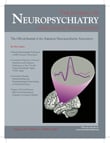Clozapine-Induced Cataplexy
SIR: Cataplexy is an abnormal state characterized by atonia and believed to represent dissociated REM (rapid eye movement) phenomena that intrude into wakefulness. Cataplexy-like phenomenon as a rare side effect of clozapine treatment was initially reported by Chiles et al. 1 in a series of four people with schizophrenia who were on variable doses of clozapine. Blum 2 also noted cataplexy during clozapine treatment along with hyperthermia and increased REM sleep. We report another patient presenting with this rare side effect of clozapine and attempt to explain the phenomenon with possible neurobiological mechanisms.
Case Report
A 29-year-old unmarried woman with unremarkable past, family and personal history presented with an episodic illness of 4 years duration suggestive of schizoaffective disorder, manic type. As she remained symptomatic even after adequate trials with various antipsychotics along with mood stabilizers, clozapine was introduced. She was on a regimen of sodium valproate, 1000mg/day, when clozapine was initiated and gradually hiked to 150mg/day. Though her symptoms decreased significantly, she started complaining of a sudden onset of knee-buckling along with dropping objects, which was not associated with any emotional trigger, loss of awareness, or falling. She did not complain of sleep troubles at that time. The phenomenon started occurring in the first week after reaching 150mg/day and was taking place two to three times per day. A detailed neurological examination and laboratory work-up were unremarkable. Valproate serum levels were at 120 and 125μg/dl on two different occasions. A 32-channel 1-hour EEG (electroencephalogram) study revealed background slowing in 4.5–5 Hz theta range with no epileptiform abnormality. Clozapine was reduced to 125mg/day and cataplectic attacks decreased in frequency to one to two attacks on alternate days. Repeat EEG after a month was similar to the previous one. Increasing the dose of sodium valproate to 1200mg/day did not alter the frequency of such attacks. Because she continued to drop objects, administration of clozapine was stopped, followed by complete cessation of cataplexy attacks.
Comment
We can make three important observations from the case presentation. The example of cataplexy in our case was mild and probably a nonepileptic phenomenon. Such EEG descriptions were not previously included in Chiles’ case series. Additionally, our patient did not have any sleep disorder. This corroborates with Chiles’ description and the dissociation is supported by the recent finding that mechanisms for triggering cataplexy are different from those for REM sleep. 3
The exact mechanism of drug-induced cataplexy is still unknown. Work on canine narcolepsy 3 suggests abnormality in the noradrenergic system, which influences dopamine D2/D3 receptors via a presynaptic mechanism, as key for generation of cataplexy. Another important mechanism is a lack of orexin-induced facilitation of motoneurons in cataplexy. 4 Clozapine is known for antagonism of noradrenergic α 1 and α 2 receptors and a recent study found that it can inhibit orexin A action. 5 Based on these recent neurobiological insights, we propose that clozapine’s significant antiadrenergic effects coupled with inhibition of orexinergic transmission could possibly underlie the emergence of cataplexy.
1. Chiles JA, Cohn S, McNaughten A: Dropping objects: possible mild cataplexy associated with clozapine. J Nerv Ment Dis 1990; 178:663–664Google Scholar
2. Blum A: Triad of hyperthermia, increased REM sleep, and cataplexy during clozapine treatment? J Clin Psychiatry 1990; 51:259–260Google Scholar
3. Nishino S, Arrigoni J, Valtier D, et al: Dopamine D 2 mechanisms in canine narcolepsy. J Neurosci 1991; 15:2666–2671 Google Scholar
4. Yamuy J, Fung SJ, Xi M, et al: Hypocretinergic control of spinal cord motoneurons. J Neurosci 2004; 24:5336–5345Google Scholar
5. Monda M, Viggiano A, Viggiano A, et al: Clozapine blocks sympathetic and thermogenic reactions induced by orexin A in rat. Physiol Res 2004; 53:507–513Google Scholar



